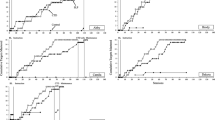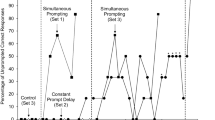Abstract
Two studies are presented in which common prompting procedures were evaluated while teaching children with autism to build Lego® play structures. In the first study, most-to-least (MTL) and least-to-most (LTM) prompting were compared. All participants learned to build the play structures when the teacher used MTL, which was associated with fewer errors than LTM. Nonetheless, three participants learned more quickly with LTM. This finding suggests that MTL may prevent errors, but it sometimes slows learning. The second study compared LTM to MTL without and with a delay (MTLD). MTLD provided an opportunity for the child to independently initiate responding but still minimized the likelihood of errors. Results showed that acquisition was nearly as rapid when the teacher used MTLD as LTM but it produced fewer errors than LTM. Best practice guidelines for choosing prompting procedures are proposed.
Similar content being viewed by others
References
Cooper, J. O., Heron, T. E., & Heward, W. L. (2007). Applied behavior analysis. second edition. Upper Saddle River, New Jersey: Merril, 1987.
Cronin, K. A., & Cuvo, A. J. (1979). Teaching mending skills to mentally retarded adolescents. Journal of Applied Behavior Analysis, 12, 401–406.
Cuvo, A. J., Leaf, R. B., & Borakove, L. S. (1978). Teaching janitorial skills to the mentally retarded: acquisition, generalization and maintenance. Journal of Applied Behavior Analysis, 11, 345–355.
Demchak, M. (1990). Response prompting and fading methods: A review. American Journal of Mental Retardation, 94, 603–615.
Fisher, W. W., Piazza, C. C., Bowman, L. G., Hagopian, L. P., Owens, J. C., & Slevin, I. (1992). A comparison of two approaches for identifying reinforcers for persons with severe and profound disabilities. Journal of Applied Behavior Analysis, 25, 491–498.
Foxx, R. M. (1982). Increasing behaviors of persons with severe retardation and autism. Champaign, Illinois: Research Press, 1982.
Gast, D. L., Doyle, P. M., Wolery, M., & Ault, M. J. (1991). Assessing the acquisition of incidental information by secondary-age students with mental retardation: comparison of response prompting strategies. American Journal of Mental Retardation, 96, 63–80.
Glendenning, N. J., Adams, G. L., & Sternberg, L. (1983). Comparison of prompt sequences. American Journal of Mental Deficiency, 88, 321–325.
Kayser, J. E., Billingsley, F. F., & Neel, R. S. (1986). A comparison of in-context and traditional instructional approaches: Total task, single trial versus backward chaining, multiple trials. Journal of the Association for the Severely Handicapped, 11, 28–38.
MacDuff, G. S., Krantz, P. J., & McClannahan, L. E. (1993). Teaching children with autism to use photographic activity schedules: maintenance and generalization of complex response chains. Journal of Applied Behavior Analysis, 26, 89–97.
Maciag, K. G., Schuster, J. W., Collins, B. C., & Cooper, J. T. (2000). Training adults with moderate and severe mental retardation in vocational skills using a simultaneous prompting procedure. Education and Training in Mental Retardation and Developmental Disabilities, 35, 306–316.
Schleien, S. J., Ash, T., Kiernan, J., & Wehman, P. (1981). Developing independent cooking skills in a profoundly retarded woman. Journal of the Association for the Severely Handicapped, 6, 23–29.
Spooner, F. (1984). Comparisons of backward chaining and total task presentation in training severely handicapped persons. Education and Training of the Mentally Retarded, 19, 15–22.
Terrace, H. S. (1963). Discrimination learning with and without “errors”. Journal of the Experimental Analysis of Behavior, 6, 1–27.
Walls, R. T., Zane, T., & Ellis, W. D. (1981). Forward and backward chaining, and whole task methods. Behavior Modification, 5, 61–74.
Weeks, M., & Gaylord-Ross, R. (1981). Task difficulty and aberrant behavior in severely handicapped students. Journal of Applied Behavior Analysis, 14, 449–463
Author information
Authors and Affiliations
Corresponding author
Additional information
This research was supported by the New England Center for Children and is based, in part, on the thesis completed by Stacie Bancroft in partial fulfillment of requirements for a Masters of Science degree from Northeastern University.
We wish to thank Richard Foxx and Brian Iwata for their help, encouragement and feedback. Special thanks to Rick Graff and Susan Langer for their contributions.
Rights and permissions
About this article
Cite this article
Libby, M.E., Weiss, J.S., Bancroft, S. et al. A Comparison of Most-to-Least and Least-to-Most Prompting on the Acquisition of Solitary Play Skills. Behav Analysis Practice 1, 37–43 (2008). https://doi.org/10.1007/BF03391719
Published:
Issue Date:
DOI: https://doi.org/10.1007/BF03391719




